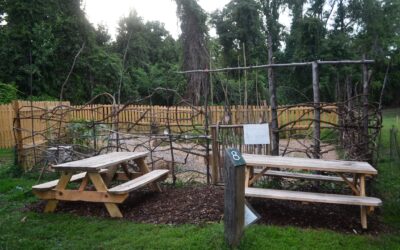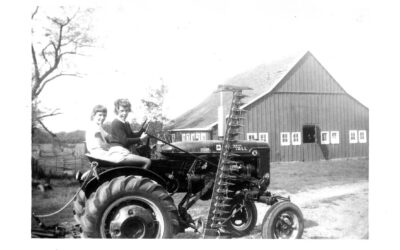About Goshen Farm
Goshen Farm, originally encompassing 290 acres, was patented as Leonard’s Neck in 1663. Over the years, the land changed hands, and in 1975, the Anne Arundel County Board of Education acquired parts of the land for schools. The remaining land was sold, and established a Living Trust. The Goshen Farm Preservation Society was formed to restore and preserve the historic Goshen Farm and the “Radoff” House, which is one of the few remaining examples of a Colonial farm in Anne Arundel County. Learn more about the detailed history below.
Detailed History of Goshen Farm
Goshen Farm’s land originally consisted of 290 acres and was patented as Leonard’s Neck in 1663. Henry Woolchurch assigned the land to Alexander Gardiner and John Wray in 1669. In 1754 the land was bequeathed to Richard Gardiner and John Hall from their father, John Pettibone Gardiner. In 1783 Richard Gardiner owned 149 acres, and by 1797 it had increased to 179 acres. Goshen Farm was built sometime in the late 1780s. It was first listed on the tax records in 1798. The house was two rooms on the bottom floor and two above. It was assessed at $120.
Early 1800s
Richard and his wife Anne Merriken Gardiner had five sons. From the 1800 census, we see that he had nine enslaved people living on the property to help them work the farm. In 1810 it had increased to 12. Richard died in 1812. In his estate, he left horses, oxen, cows, pigs, sheep, bee hives, and canoes among his other personal possessions. He left the land (292 acres) to be divided by his five sons, and in 1839, Richard Gardiner Jr. purchased his brothers’ portion.
In 1847 Richard Jr. died, leaving everything to his ward, Thomas Jefferson Hall. In his estate, he also left oxen, cows, pigs, sheep, horses, mules, and geese, plus corn, wheat, wool, beets, salt, buckwheat, and cabbage among his effects. His estate also tells us who purchased these items and what they paid.
Henry Tydings purchased the house and the remaining 179 acres at auction. He had another structure, a small house that sat somewhere else on the property, moved up to the main house to serve as the kitchen. Although there are rumors of what this other little house was for, I believe it was probably built for one of Richard Gardner Sr.’s five sons.
Henry married Margaret Stinchcomb, who lived in the “Stinchcomb” house on Swan Dr. in Cape St. Claire. The Stinchcomb and Tydings families were very close and shared labor between the two farms. Henry and Margaret had four children. With his second wife, Eleanor Foreman, Henry had his last child, Mary L. Tydings. Mary and her husband, Charles Carroll Brice, lived with Henry at Goshen and helped him run the farm.
Early 1900s
In 1911 Henry passed away, and Mary purchased the farm from her half-siblings. She and “Carroll” ran a dairy farm there. Mary sold off 4 ½ acres of land to the St. Margaret’s Hunt Club (which is on Cape St. Claire Road and is a private residence now). She also sold off pieces of the farm to Dr. Hugh Hampton Young for the development of Cape St. Claire.
The Brices lived on the farm until approximately 1935. Around 1930, they built a small cottage for one of their sons. The property changed hands several times, one being to Roland Edgar Bell (rumored to be a relative to Alexander Graham Bell). He purchased the farm and lived there for approximately two years. He then sold the farm to Romeo and Mary Jondreaus. Due to an unfortunate accident, the Jondreaus had to sell the farm, which is when Dr. Morris Leon Radoff purchased it- around 1942.
Dr. Radoff was the Maryland State Archivist, a professor, and an avid reader. His wife May was from a prominent Baltimore Silver family. Goshen Farm had no electricity. Although Dr. Radoff was prepared to pay for an electric pole installed for the house, the state would not do this until after World War II.
Dr. and Mrs. May Radoff had goats, chickens, horses, and cattle on their farm. May grew herbs and flowers and loved their bird dogs. They planted a Victory Garden. Dr. Radoff was approached several times during the development of Cape St. Claire to sell his land, which he refused to do. In 1967 the Anne Arundel County Board of Education approached him to buy 30 acres of his land for the elementary school. Dr. Radoff negotiated for a slightly better price than they wanted to pay. He had the house put on the Maryland Register of Historic Places. In 1975 the school board returned to him to take the remaining land for a Junior High School. Under duress, Dr. Radoff sold the remaining land and set up a Living Trust so that he and May could live out their years on what was left of his farm.
The 1970s
Dr. Radoff fought hard to save his property and began applying to put the house on the National Register of Historic Homes. The school board denied that, as they owned the home by then. In 1977 Dr. Radoff died. His wife lived in the home until her death in mid-1991. A series of caretakers have since lived in the home. Trash had been dumped there, and it was unkempt. In 2005 or so, the last tenant moved out, and since then, the house has sat empty.
The Goshen Farm Preservation Society was established to restore and preserve the historic Goshen Farm and “Radoff” House. This farm is an essential part of the history of Cape St. Claire, the Broadneck Peninsula, and Anne Arundel County. This property is located behind the Cape St. Claire Elementary School and is one of the few examples left of a Colonial farm in the county.

